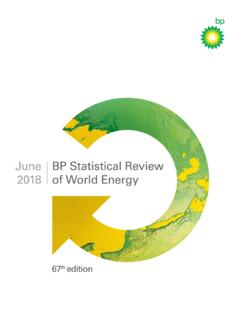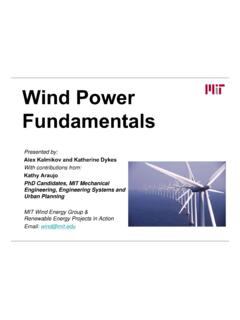Transcription of BP Statistical Review
1 BP Statistical Review of World Energy2019 | 68th editionContentsDiscover more onlineAll the tables and charts found in the printed edition are available at plus a number of extras, including: The energy charting tool view predetermined reports or chart specific data according to energy type, region, country and year. Historical data from 1965 for many sections. Additional country and regional coverage for all consumption tables. Additional data for refined oil production demand, natural gas, coal, hydroelectricity, nuclear energy and renewables. PDF versions and PowerPoint slide packs of the charts, maps and graphs, plus an Excel workbook and database format of the data. Regional and country factsheets. Videos and the BP World Energy appExplore the world of energy from your tablet or smartphone. Customize charts and perform the calculations. Review the data online and offline. Download the app for free from the Apple App Store and Google play store.
2 Introduction 1 Group chief executive s introduction 2 2018 at a glance 3 Group chief economist s analysis Primary energy 8 Consumption 9 Consumption by fuel 12 Consumption per capita Oil 14 Reserves 16 Production 20 Consumption 24 Prices 26 Refining 28 Trade movements Natural gas 30 Reserves 32 Production 34 Consumption 37 Prices 38 Trade movements Coal 42 Reserves 44 Production 45 Consumption 47 Prices and trade movements Nuclear energy 48 Consumption Hydroelectricity 49 Consumption Renewable energy 51 Renewables consumption 52 Generation by source 53 Biofuels production Electricity 54 Generation 56 Generation by fuelCO2 Carbon 57 Carbon dioxide emissions Key minerals 58 Production 59 Reserves 59 Prices Appendices 60 Approximate conversion factors 60 Definitions 61 More informationFor 66 years, the BP Statistical Review of World Energy has provided high-quality objective and globally consistent data on world energy markets.
3 The Review is one of the most widely respected and authoritative publications in the field of energy economics, used for reference by the media, academia, world governments and energy companies. A new edition is published every more onlineAll the tables and charts found in the latest printed edition are available at plus a number of extras, including: The energy charting tool view predetermined reports or chart specific data according to energy type, region, country and year. Historical data from 1965 for many sections. Additional data for refined oil production demand, natural gas, coal, hydroelectricity, nuclear energy and renewables. PDF versions and PowerPoint slide packs of the charts, maps and graphs, plus an Excel workbook of the data. Regional and country factsheets. Videos and OutlookWatch the BP Energy Outlook 2017 video, containing our projections of long-term energy trends to 2035.
4 Download the booklet and presentation materials at the conversation#BPstatsDownload the BP World Energy appExplore the world of energy from your tablet or smartphone. Customize charts and perform the calculations. Review the data online and offline. Download the app for free from the Apple App Store and Google play data series for proved oil and gas reserves in BP Statistical Review of World Energy June 2017 does not necessarily meet the definitions, guidelines and practices used for determining proved reserves at company level, for instance, as published by the US Securities and Exchange Commission, nor does it necessarily represent BP s view of proved reserves by country. Rather, the data series has been compiled using a combination of primary official sources and third-party Statistical Review of World Energy 20191 Group chief executive s introductionThe developments documented in this year s Statistical Review highlight a critical challenge facing the global power sector.
5 Power demand increased even more strongly than overall energy demand in 2018, as the world continued to electrify. But this shift towards greater electrification can play an important part in the energy transition only if it is accompanied by a decarbonization of the power sector. Despite the continuing rapid growth in renewable energy last year, it provided only a third of the required increase in power generation, with coal providing a broadly similar contribution. Indeed, the increasing use of coal within the power sector is estimated to have more than accounted for the entire growth of global coal consumption last , the electric power sector is estimated to have absorbed around half of the growth in primary energy in 2018 and accounted for around half of the increase in carbon emissions. Decarbonizing the power sector while also meeting the rapidly expanding demand for power, particularly in the developing world, is perhaps the single most important challenge facing the global energy system over the next 20 years.
6 Renewable energy has a vital role to play in meeting that challenge. But it is unlikely to be able to do so on its own. A variety of different technologies and fuels are likely to be required, including extensive coal-to-gas switching and the widespread deployment of carbon capture, use and storage (CCUS). As I have said before, this is not a race to renewables, it is a race to reduce carbon emissions across many industry, and society more generally, face significant challenges as we navigate the transition to a low carbon energy system. That will require understanding and judgement, both of which rely on the kind of objective data and analysis found in the Statistical Review . We are proud of the role that the BP Statistical Review has played in informing public debate over the past 68 years and I hope that you find it a useful resource for your own discussions and me conclude by thanking BP s economics team and all those who have helped us prepare this Review particularly those governments and Statistical agencies around the world who have contributed their official data again this year.
7 Thank you for your continuing co-operation and DudleyGroup chief executiveJune 2019In particular, the data compiled in this year s Review suggest that in 2018, global energy demand and carbon emissions from energy use grew at their fastest rate since 2010/11, moving even further away from the accelerated transition envisaged by the Paris climate goals. BP s economics team estimate that much of the rise in energy growth last year can be traced back to weather-related effects, as families and businesses increased their demand for cooling and heating in response to an unusually large number of hot and cold days. The acceleration in carbon emissions was the direct result of this increased energy consumption. Even if these weather effects are short-lived, such that the growth in energy demand and carbon emissions slow over the next few years, there seems little doubt that the current pace of progress is inconsistent with the Paris climate goals.
8 The world is on an unsustainable path: the longer carbon emissions continue to rise, the harder and more costly will be the eventual adjustment to net-zero carbon emissions. Yet another year of growing carbon emissions underscores the urgency for the world to Statistical Review provides a timely and objective insight into those developments and how that change can begin to be achieved. The strength in energy consumption was reflected across all the fuels, many of which grew more strongly than their recent historical averages. This acceleration was particularly pronounced for natural gas, which grew at one of its fastest rates for over 30 years, accounting for over 40% of the growth in primary energy. On the supply side, the data for 2018 reinforced the central importance of the US shale revolution. Remarkably, the US recorded the largest ever annual increases by any country in both oil and natural gas production last year, with the vast majority of both increases coming from onshore shale plays.
9 At the same time, renewable energy, led by wind and solar power, continued to grow far more rapidly than any other form of to the BP Statistical Review of World Energy, which records the events of 2018: a year in which there was a growing divide between societal demands for an accelerated transition to a low carbon energy system and the actual pace of Statistical Review of World Energy 201922018 at a glanceGlobal primary energy consumption grew rapidly in 2018, led by natural gas and renewables. Nevertheless, carbon emissions rose at their highest rate for seven developments Primary energy consumption grew at a rate of last year, almost double its 10-year average of per year, and the fastest since 2010. By fuel, energy consumption growth was driven by natural gas, which contributed more than 40% of the increase. All fuels grew faster than their 10-year averages, apart from renewables, although renewables still accounted for the second largest increment to energy growth.
10 China, the US and India together accounted for more than two thirds of the global increase in energy demand, with US consumption expanding at its fastest rate for 30 emissions Carbon emissions grew by , the fastest growth for seven The annual average oil price (Dated Brent) rose to $ per barrel, up from $ in 2017. Oil consumption grew by an above-average million barrels per day (b/d), or China (680,000 b/d) and the US (500,000 b/d) were the largest contributors to growth. Global oil production rose by million b/d. Almost all of the net increase was accounted for by the US, with their growth in production ( million b/d) a record for any country in any year. Elsewhere, production growth in Canada (410,000 b/d) and Saudi Arabia (390,000 b/d) was outweighed by declines in Venezuela (-580,000 b/d) and Iran (-310,000 b/d). Refinery throughput rose by 960,000 b/d, down from million b/d in 2017.
















